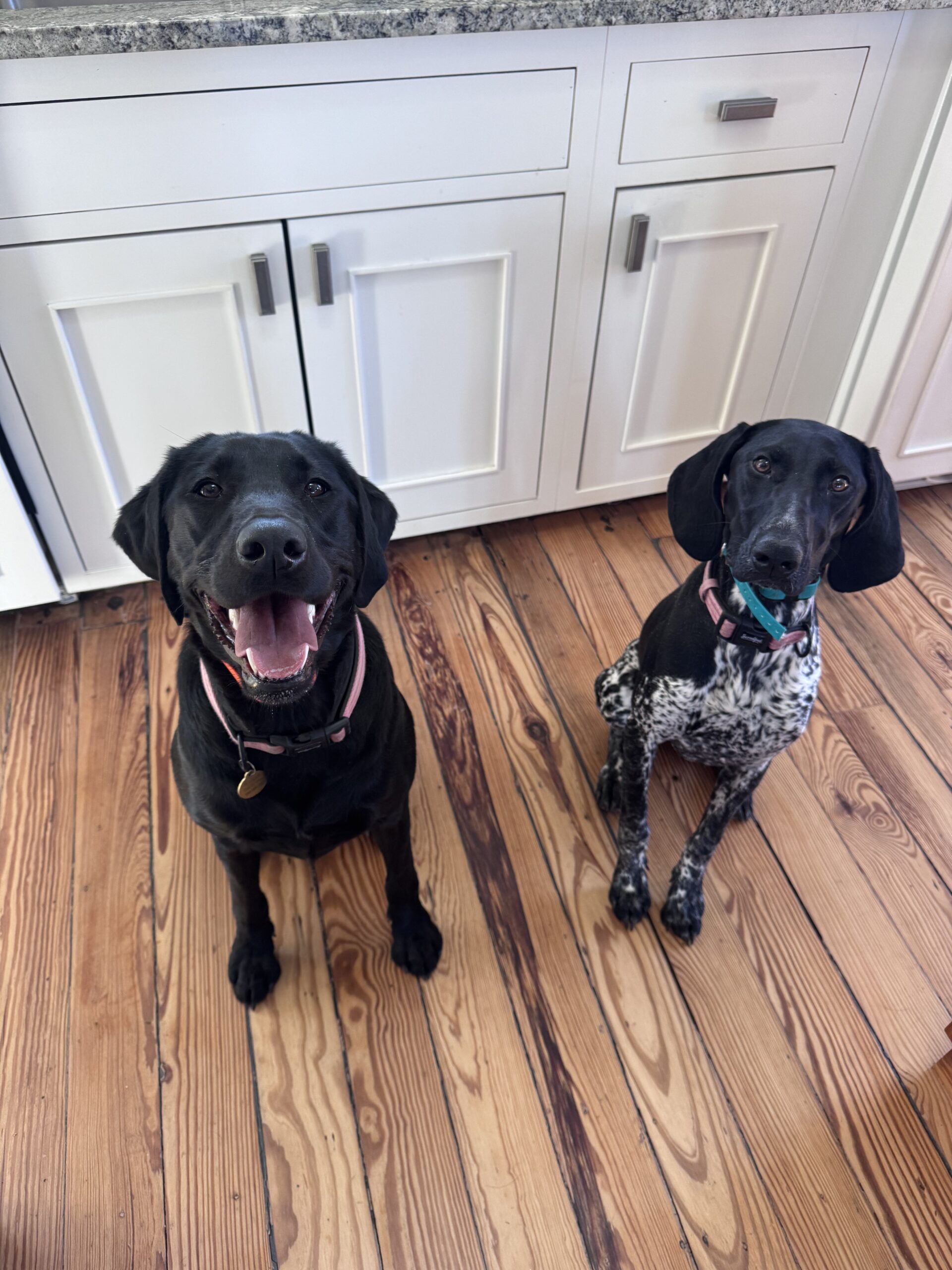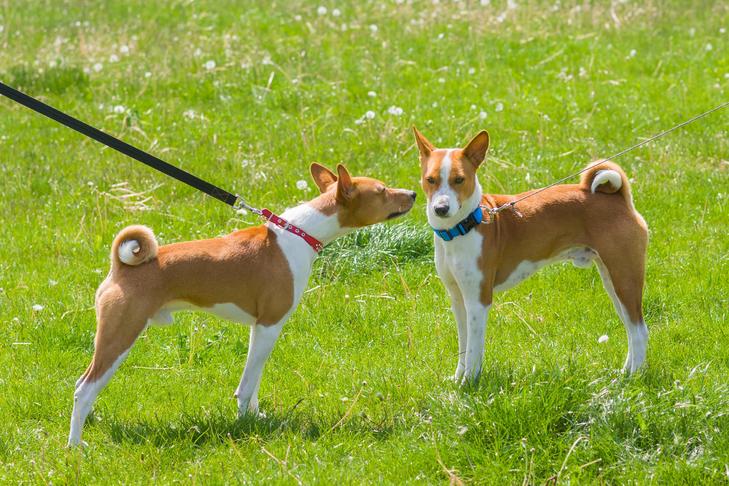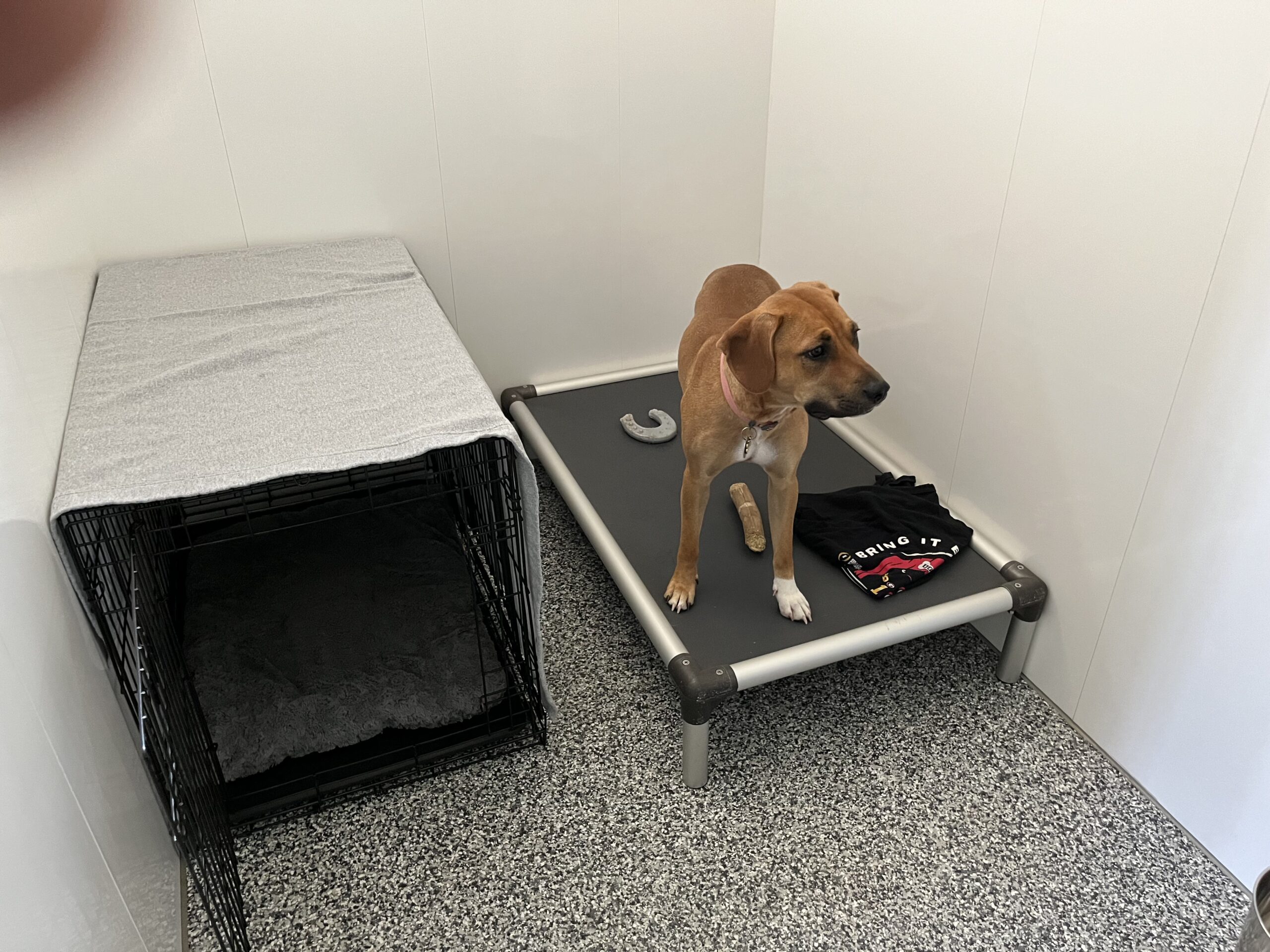Genetics Vs. Training in Dogs
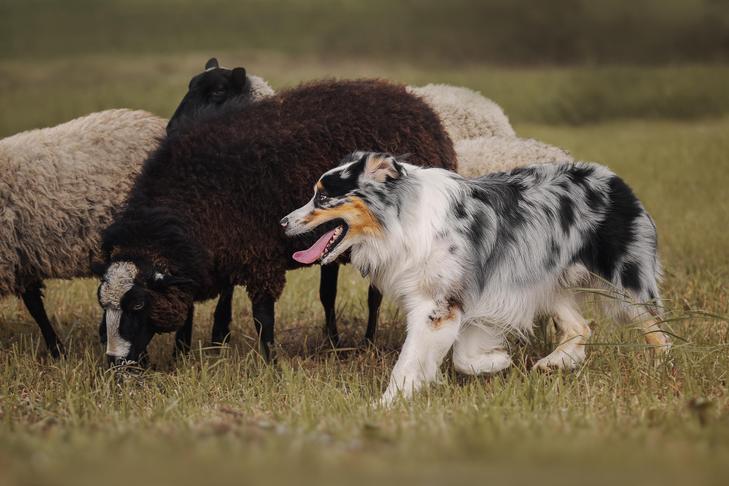
Genetics shape everything from a dog’s instincts to their patience, curiosity, and sensitivity to correction. When we understand how breed traits affect behavior, we stop trying to “fix” dogs and start learning how to guide them.
A dog’s breed influences their natural instincts, energy level, and ability to learn. Understanding dog genetics and training helps owners work with those instincts instead of against them — creating calmer, more confident dogs through balanced, breed-specific training.
Why Genetics Is the Foundation of Behavior
Every dog has a story written in their DNA. Some were bred to guard, others to herd or retrieve — and those instincts still live beneath the surface. This post explores how breed-specific dog training builds trust and how one German Shepherd named Anakin showed us what happens when genetics and guidance come together. (read this article by AKC for more detailed information) You will find this blog post extremely helpful Why Genetics Matter in Dog Behavior and Training Success
The Role of Genetics in Dog Training
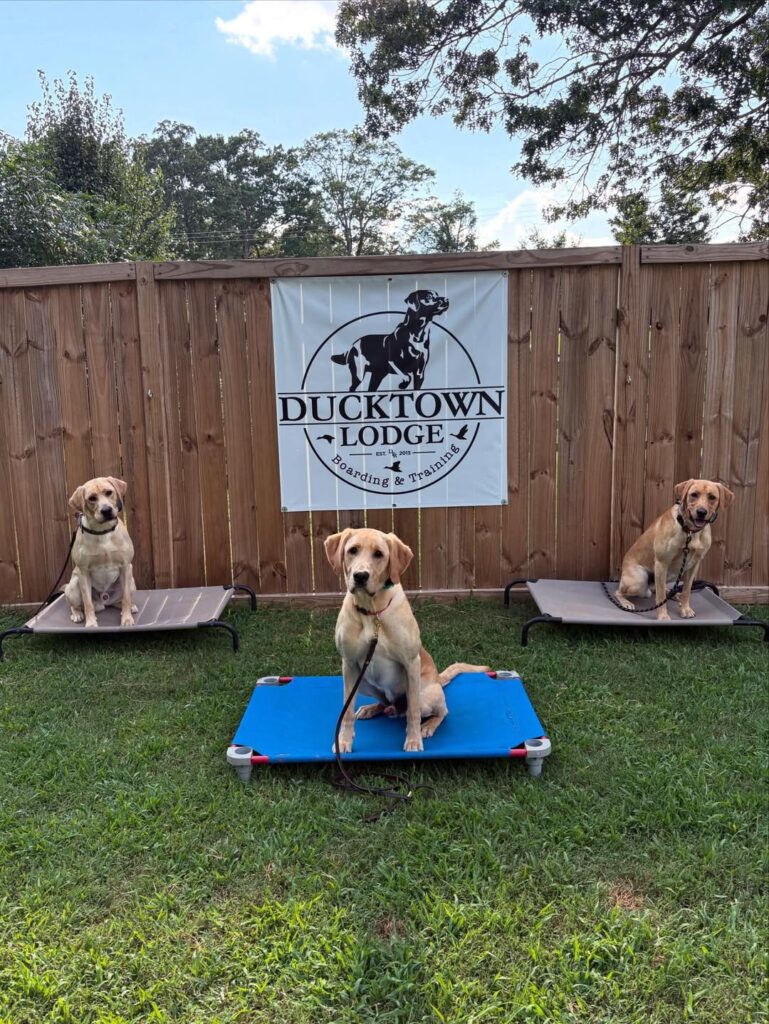
Dog training starts long before a leash is ever clipped on — it starts with genetics. A dog’s breed shapes how they think, what motivates them, and how they respond to structure. Understanding dog genetics and training allows us to guide behavior in a way that feels natural to the dog, not forced.
Every breed was created with a purpose. Those instincts still influence how dogs learn today:
- Herding breeds like Border Collies are wired to control movement, often using eye contact or gentle nips.
- Retrievers were bred to fetch and carry, making them eager to please and responsive to repetition.
- Guardians like German Shepherds and Rottweilers are naturally protective, alert, and loyal to their people.
When owners ignore these instincts, training can become frustrating — for both human and dog. But when we align our approach with a dog’s genetic blueprint, things click into place. Commands turn into communication, and training becomes a partnership rather than a battle.
That’s why balanced dog training isn’t just a philosophy — it’s a recognition of what’s already true. Each dog brings their own temperament, instincts, and emotional wiring to the table. Our job is to understand the dog in front of us and help them succeed within who they are, not who we expect them to be.
Meet Anakin: When Genetics Meet Real Life
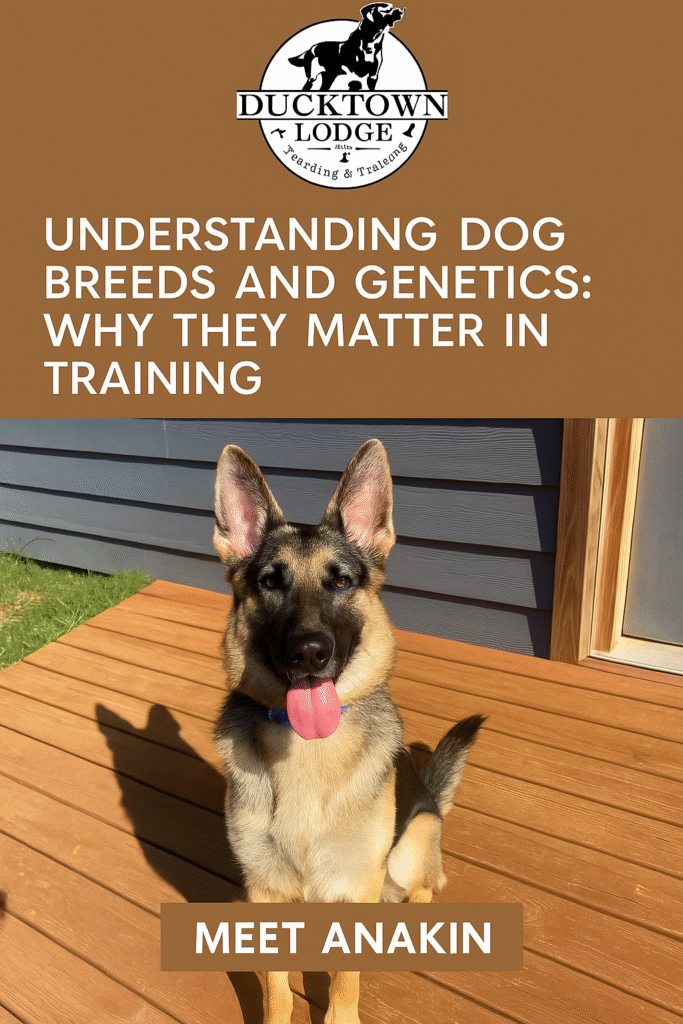
Anakin’s story is a reminder that understanding dog behavior begins with understanding who the dog is. When he first arrived at Ducktown Lodge, this striking German Shepherd carried both beauty and burden — loyal to his core but overwhelmed by the need to protect.
His owner adored him deeply but struggled to manage his growing anxiety and guarding behavior. Her husband’s severe pet dander allergy made things harder, and eventually, she made the heart-wrenching choice to rehome Anakin somewhere he could get the structure and support he needed.
At first glance, his behavior looked like aggression — guarding, pacing, and intense focus on his surroundings. But through the lens of genetics, it made perfect sense. German Shepherds are bred for vigilance and protection. Those instincts don’t turn off just because a dog is living in a home. Without leadership and clarity, they often take that responsibility upon themselves.
Recognizing the why behind a dog’s actions changes everything. For Anakin, his training wasn’t about punishment or control — it was about helping him understand that he didn’t need to be on duty all the time. Balanced dog training starts with compassion, not correction, and Anakin became the perfect example of how breed-specific dog training creates peace through understanding.
Dog Training & Genetics Matter When Bringing a Dog Home

Bringing home a dog isn’t just about finding the cutest face — it’s about understanding what’s beneath the surface. Every breed carries generations of purpose in its genes. Knowing how breed affects dog training helps owners set clear expectations from day one.
When you match a dog’s instincts and energy level with your home and lifestyle, you create a foundation for success. Ignoring those natural drives can lead to confusion, stress, or unwanted behaviors.
Here are a few real-world examples of how genetics shape daily life:
- Herding breeds like Border Collies or Australian Shepherds are built to manage movement. Without structured outlets, they may start herding children, chasing cars, or struggling to relax indoors.
- Guardian breeds such as German Shepherds or Rottweilers were bred to protect. Without clear boundaries and calm leadership, they can become overly alert or suspicious of strangers.
- Retrievers and sporting breeds are happiest when given a job. A game of fetch, swim, or scent work taps into their purpose and builds confidence.
- Companion breeds thrive on closeness and predictability. Leaving them alone for long hours without engagement can create anxiety.
Every dog’s genes tell a story — and your job as an owner is to read it well. Understanding dog genetics and training doesn’t mean excusing unwanted behavior. It means knowing why your dog reacts the way they do, so you can train with empathy instead of frustration.
At Ducktown Lodge, we call this training the dog in front of you. It’s about seeing the whole picture — genetics, environment, and emotion — and meeting the dog where they are, not where we wish they were.
The German Shepherd: A Case Study in Genetics and Training
Few breeds demonstrate the link between genetics and training as clearly as the German Shepherd. Originally bred for herding and protection work, these dogs are a blend of loyalty, intelligence, and intensity. Their instincts run deep — they are thinkers, watchers, and natural problem-solvers.
German Shepherds don’t simply follow; they assess. Their protective nature, quick learning, and emotional sensitivity make them remarkable companions, but they also make them vulnerable to stress when they lack structure or clear leadership.
Many owners fall in love with the breed’s beauty and confidence but underestimate what those traits demand. Without balanced dog training, German Shepherds may start making decisions on their own — guarding the front door, policing other pets, or becoming anxious when visitors arrive.
The key isn’t to suppress these traits but to guide them. Here’s how breed-specific dog training helps Shepherds thrive:
- Clear roles and routines. Consistency tells them when they can relax and when to engage.
- Controlled socialization. Exposure to people and dogs in a calm setting builds confidence without overstimulation.
- Structured outlets. Tasks like obedience drills, nose work, or hiking tap into their working drive in healthy ways.
- Leadership through calm energy. Shepherds mirror their handler’s tone — firm, quiet direction keeps them grounded.
As we often say at Ducktown Lodge, a guard dog doesn’t need to protect everything — they just need to know when it’s your job and when it’s theirs.
When trained through understanding rather than pressure, German Shepherds reveal their best selves: loyal, relaxed, and deeply attuned to their humans. Anakin’s story proves it.
Anakin’s Rehabilitation: From Guarding to Confidence
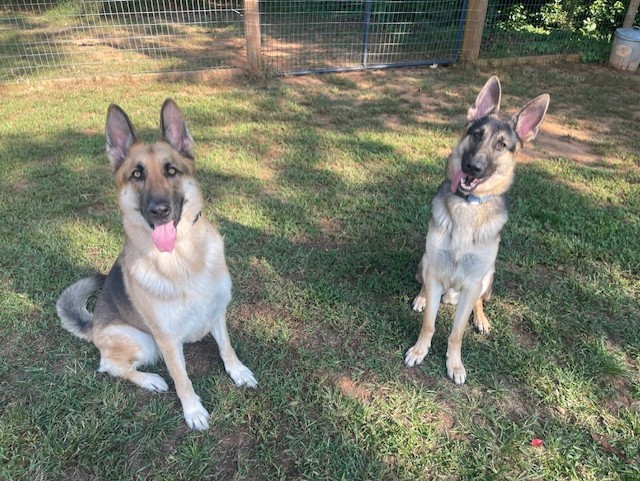
When Anakin first came to Ducktown Lodge, his world revolved around vigilance. Every sound was a potential threat, and every visitor a situation to manage. But what looked like aggression was really anxiety — the weight of a dog trying too hard to do his job without the clarity he needed.
Through balanced dog training and calm, consistent leadership, Anakin began to relax. We didn’t suppress his instincts — we redirected them. His training focused on communication and trust instead of control.
Here’s what his journey looked like:
- Clarity through consistency. Anakin learned daily routines and predictable patterns that helped him feel safe.
- Impulse control and boundaries. Instead of reacting, he practiced pausing — learning to wait for direction before acting.
- Confidence building. Success in small, structured exercises built his self-assurance and reduced his need to “manage” others.
- Handler communication. By reinforcing calm, steady cues, his trainers taught him that leadership came from people, not instinct.
Over time, the tension melted away. Anakin’s eyes softened, his responses slowed, and he began to trust that someone else was in charge.
When he eventually met his new family — experienced German Shepherd owners — it was an easy transition. They understood his genetics, respected his need for structure, and gave him the continued consistency every Shepherd thrives on. Today, he’s not just obedient — he’s confident, grounded, and genuinely happy.
Anakin’s transformation wasn’t about changing who he was. It was about helping him understand when to be who he was — and that’s the heart of breed-specific dog training.
Training Through Understanding
Training isn’t one-size-fits-all — and genetics are the reason why. Every dog carries a blueprint that shapes how they responds to the world. When we understand that blueprint, training becomes less about control and more about connection.
At Ducktown Lodge, we focus on balanced dog training that honors a dog’s instincts while building calm, steady behavior. It’s not about “fixing” dogs — it’s about helping them feel secure and clear about what’s expected.
Here’s how you can begin understanding dog behavior through the lens of genetics:
- Learn your dog’s story. Study their breed’s history and purpose. Knowing why your dog does something is the first step to guiding them.
- Work with, not against, instincts. A herding dog needs direction; a retriever needs a job; a guardian needs leadership.
- Keep communication simple. Dogs read energy before words — calm guidance always outperforms chaos.
- Use structure to build freedom. Clear boundaries don’t limit a dog — they give them safety and confidence to relax.
When you embrace breed-specific dog training, you stop asking your dog to be someone they’re not. Instead, you show them how to thrive within who they already are.
Every success story at Ducktown Lodge — from anxious shepherds to sensitive spaniels — starts with one question: Who is this dog, really? Once we answer that, everything else falls into place.
Final Thoughts: Genetics Are the Foundation of Success
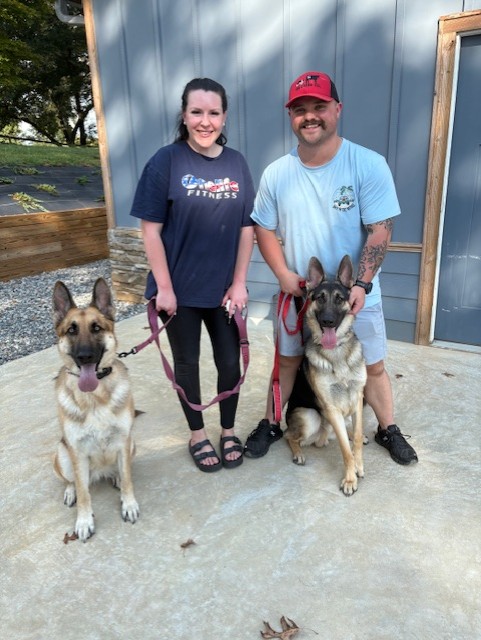
Anakin’s story will always stay close to our hearts — not because he was challenging, but because he was misunderstood until someone finally saw who he really was. That’s what training with understanding looks like.
Sara led Anakin’s training here at Ducktown Lodge, and from the first moment, she knew he wasn’t “difficult.” He was doing exactly what he was bred to do — protect, assess, and stay alert. Her work with him wasn’t about shutting that off. It was about showing him that he didn’t need to carry that weight anymore.
Every session was quiet, steady, and intentional. Sara used balanced dog training rooted in empathy and structure — guiding Anakin through small wins that built his confidence. There were days when he was uncertain, and she’d simply sit beside him, breathing calm into the space until he softened.
We were invested in him not just as a training project, but as a life. We celebrated the first time he took direction without tension, the first time his tail wagged freely, and the moment he leaned into Sara’s side instead of standing guard.
That’s what we mean when discussing understanding dog genetics and training — seeing the whole dog. Anakin wasn’t “fixed.” He was understood.
When he finally found his new family — a couple who shared our respect for the German Shepherd’s heart and heritage — we knew he was ready. They didn’t adopt a “perfect dog.” They adopted a dog who had learned to trust again.
For us, that’s success. It’s not about obedience scores or quick turnarounds. It’s about the quiet moment when a dog exhales and knows they’re safe.
At Ducktown Lodge, that’s the goal of every training journey — to help dogs and their people build peace through clarity, compassion, and respect for who that dog was always meant to be.
When You’re Ready to Understand Your Dog
If you’ve ever looked at your dog and wondered why they do what they do — why they guard, herd, chase, or struggle to settle — you’re not alone. Those instincts aren’t flaws. They’re stories written in their DNA, waiting to be understood.
At Ducktown Lodge, we help you read those stories clearly. Whether your dog needs structure, balance, or just a calmer rhythm to life, we’ll walk that path with you — patiently, kindly, and with respect for who your dog really is.
Sara and Lucinda approach every dog like they did with Anakin: quietly, consistently, and with the belief that transformation comes through trust. We don’t rush progress. We build it — one clear, calm moment at a time.
Because when you understand your dog’s genetics, you don’t just change their behavior — you change their peace of mind.
You don’t have to figure it out alone.
Let’s talk about your dog and what makes them unique. We’ll help you build confidence, structure, and connection — the kind that lasts long after training ends.
👉 Reach out to Ducktown Lodge to start a conversation — Call Lucinda 770-733-0836 or email hello@ducktownlodge.com

